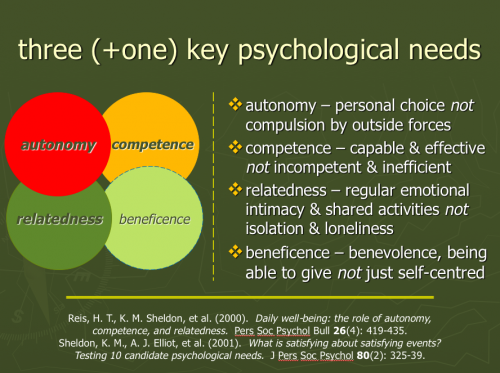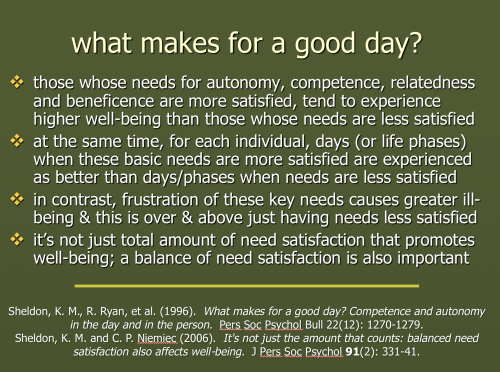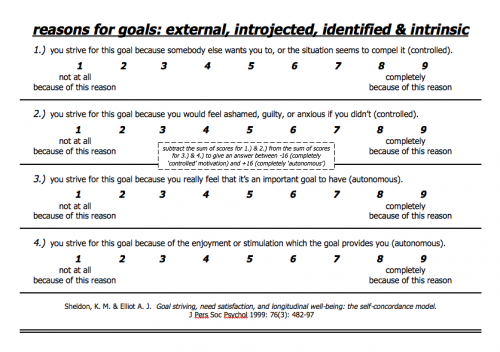“If a pickpocket meets a saint, all he sees are his pockets
” - Traditional
Social networks: the value of a self-determination theory lens
key points:
1.) I introduce self-determination theory (S-DT) - a serious contender for my favourite approach to understanding how best to build wellbeing.
2.) I discuss S-DT's very helpful understanding of our central psychological needs for autonomy, competence, relatedness & beneficence. A scale is provided so we can assess how we're doing and a second scale is also given that helps us monitor our daily satisfaction for our needs for relatedness & benevolence and what we can learn from this observation. explain a bit too about three important components of S-DT - needs, goals & motivations.
3.) Finally I say a bit about S-DT's take on goals and motivations - both of great importance if we're going to improve how well we, partners, families, friends and those around us can get our key needs met and flourish more fully.
In this second section of the book chapter on 'Social networks', I introduce the value of a Self-determination theory (S-DT) lens. Here is a link to the excellent S-DT website. This approach is, for me, an absolutely central way of helping us make good choices that move us towards health & flourishing. Here I want to touch base on three facets of S-DT that are relevant for social networks.
One is the central importance of living a life that satisfies four key psychological needs. Multiple S-DT research studies have shown that people who meet their needs for Autonomy, Competence, Relatedness & Beneficence better will tend to experience higher well-being. Those who are frustrated in trying to meet these needs will tend to experience higher ill-being. It's like monitoring our 'psychological diet'. Tracking how we're doing with these needs and making changes to meet them better is likely to be a wise thing to do. It gives us an excellent compass to check whether our lives are on track. Below are a couple of slides illustrating the four needs. You can download a set of four slides on needs here - first two & second two - and, if wanted, they can be printed out as a 2-miniatures-to-a-page double-sided handout. And here is a link to a 7 minute video clip where I talk through the four needs slides in more detail.


Obviously our social networks are at the heart of how well our needs for Relatedness and Beneficence are satisfied, and possibly too how badly they are frustrated. But social networks aren't only relevant for Relatedness and Beneficence, they are also highly relevant for our needs for Autonomy and Competence as well. The second message from S-DT I want to introduce is to encourage us to get a sense of how we're doing satisfying these four key needs. A good way of clarifying this is to fill in this downloadable "Psychological needs satisfaction measure (NSM)". You calculate your score for each of the four needs by adding your scores for the four relevant questions and then dividing the total by four to get your average score for that need. On the second side of the downloadable question sheet, figures from Study 2 at the bottom of the page give you some idea of how you're scoring compared with what may well be a roughly comparable group of people. To flourish we want to score highly, quite possibly in the top 15% of the population.
If you'd like to explore seeing how you do day-to-day, here is a second downloadable question sheet that assesses how we rate ourselves on Relatedness and Beneficence using a week's daily scoring format. Here are the four Relatedness and the four Beneficence questions:
Relatedness: R1.) I feel that the people I care about also care about me. R2.) I feel connected with people who care for me and for whom I care. R3.) I feel close and connected with other people who are important to me. R4.) I experience a warm feeling with the people I spend time with.
Beneficence: B1.) I feel that my actions have a positive impact on the people around me. B2.) The things I do contribute to the betterment of society. B3.) In general my influence in the lives of other people is positive. B4.) I have been able to improve the welfare of other people.
It's interesting to notice that the Relatedness questions focus so much on a sense of caring & being cared for, connectedness, closeness & warmth. This is certainly likely to be affected by which relationships, amongst the people you know, you choose to focus on and spend more time with. It's a lot about depth of connection. It connects too to emotional expressiveness, commitment, and compassion. And for Beneficence it's about 'making a difference'. Even toddlers are happier when they're generous - see "Giving leads to happiness in young children" - with its comment that "the present study finds that before the age of two, toddlers exhibit greater happiness when giving treats to others than receiving treats themselves. Further, children are happier after engaging in costly giving – forfeiting their own resources – than when giving the same treat at no cost." And this continues all the way through life - see, for example, "Is it better to give or to receive? Social support and the well-being of older adults" - with its conclusion that "it is often better for the well-being of older adults to give than to receive."
I've now introduced S-DT Needs and assessed how well we are meeting them using the Psychological needs satisfaction measure (NSM). The third & last point I want to take from S-DT just now is the importance of Goals & Motivations. There are four sheets it would be useful to look at in extending our understanding of S-DT. Here are a couple of slides on Goals (printable as a 2-miniatures-to-a-page handout).

Here a couple of slides on Motivations (again printable as a 2-miniature-page), here a slide on the interaction between Goals & Motivations, and here a sheet (see below) clarifying the distinction between Controlled (first two lines on the sheet) & Autonomous Motivations (second two lines). In general we're likely to satisfy our needs and build wellbeing better in our lives if our choices are largely Autonomous (although often our motivations will come from a mix of reasons), and mostly aiming for Intrinsic goals.

S-DT is such a fine way of understanding how we can nourish both relationships and wellbeing better. It has huge implications for how we can treat both ourselves and others more helpfully. And there are many research studies highlighting how this has measurable and persisting benefits - see, for example the excellent "Benefits of benevolence: basic psychological needs, beneficence, and the enhancement of well-being" and "Choices which change life satisfaction: Similar results for Australia, Britain and Germany" with their clear message that shifting more of our energy and time to kindness and appreciation of relationships is good both for our own wellbeing and for the wellbeing of those around us.
And here are links that will take you on to the next section of the Social networks chapter - Social identity & the importance of both formal & informal group memberships (background) - or back to the initial section of the chapter - Social networks: an introduction.
